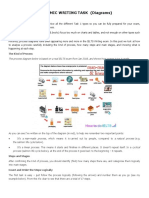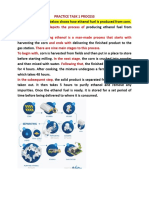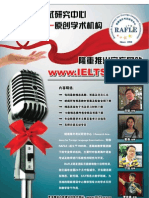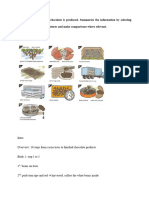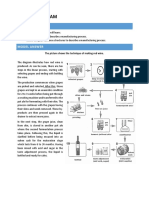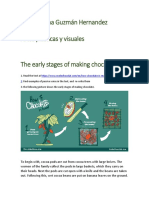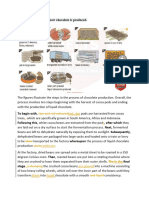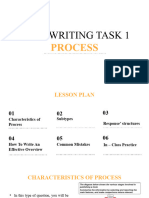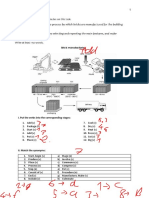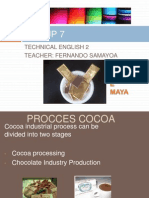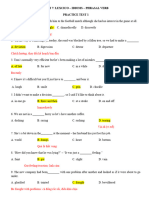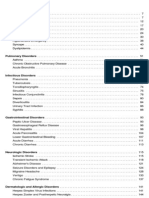Writing task 1
“
Lesson 26: Manufacturing Process
2
� Process
- The IELTS process task is designed to test your ability to compare and contrast
information shown in a process diagram, or flow chart.
Require
- Sequencing words: (first, subsequently, after that, finally.)
- Describing the location of objects.
- Passive form. This is where the sentence starts with object and the subject of the sentence is
often missed out (especially for a man-made process).
- Verb of process: remove, insert, extract, transform into, discard
- Articles: every countable noun needs an article (a, an, the)
3
� Passive form
- To form the passive, we use be + past participle (verb 3). You must use the correct form of the
verb be for number, person and tense. Usually, when we describe a process we would use the
present simple (is/are) unless it is explicitly stated to be a past or projected future process.
- If we want to include the agent of the verb we can use ‘by’.
The flowchart illustrates how chips 1. ___ (make). First of all, a twenty-ton bag of potatoes 2. ____
(deliver) to a restaurant by a big truck. The potatoes 3.___ (unload) and then they 4.___ (store) in
a cool dry place. Subsequently, the chips 5.___ (wash) by the machine. After this, the chips 6. ___
(take out of) the machine and 7. ___ (leave) to dry for one hour. Then, the chips 8. ___ (put) into a
deep fryer that cooks them at 200 degrees. Following this, the potato chips 9. ___ (remove) with a
special tool. Salt and pepper 10. ___ (add) to improve the flavor. Finally, the chips 11. ___ (put) on
a plate and the plate 12. __ (serve) to customers.
4
� Process
The diagram shows how liquid chocolate is produced.
5
� Introduction & Overview
Introduction
Always locate key words and find synonyms
- The diagram shows how liquid chocolate is produced.
- The infographic illustrates the production of liquid cacao.
6
� Introduction & Overview
Overview
- Overall, there are … steps in the process, beginning with …, followed by …., and ending with
I.e:
- Overall, there are nine steps in the process, starting with collecting water and ending with
pumping it for the utilisation of Australian people.
- Overall, to manufacture the clay containers, the raw materials need to go through an eleven-
step process, beginning with digging the raw materials, followed by several physical steps and
ending with coloring.
7
� Overview
Overall, the process requires 10 steps in total, beginning with initial harvesting of ripe pods, followed
by physical and chemical transformation, and finally producing the liquid chocolate.
� Body
A process will have a number of stages that are in time order. So you should start at the beginning,
and describe each stage through to the last one.
Processes are not always this clear, and you may have to look more carefully to spot the beginning,
and there may also be two things happening at the same time.
9
� Sequencing phrases
- The process commences with V-ing or the process commences with Noun + V-ing
- First/
- Firstly/
- First of all,
- To star with, …
- The first step | is involved + Ving
- Secondly,
- Thirdly
- Then/next/after that/following that/following on from this, …
- Subsequently/in the subsequent stage/ subsequent to that, finally.
- The process concludes with/ finishes with
- Once S + V, S + V
- S + V, followed by N/ V-ing
10
� Body 1
Body 1: Find a logical separation for your body (step 1 - 5)
Step 1: plant the cacao trees in different regions around the world namely South America, Africa
and Indonesia to collect the pods
Step 2: Once the pods are harvested, they are cut off to take out/ remove/ separate the white cocoa
beans
Step 3: ferment the beans using banana leaves
Step 4: spread the beans on a mat to dry under the sun
Step 5: pack in large bags
The first five steps involve preparing cacao pods to be processed. Firstly, ripe red pods are
collected from cacao trees which are planted in different regions around the world, namely South
America, Africa, and Indonesia. Next, the harvested pods are cut in order to separate white cocoa
beans from the pods. Following that, the beans are placed on leaves for fermentation. In the next
step, the fermented beans are dried under the sunlight before being packed in large bags for
transportation.
11
� Body 1
Body 2: Find a logical separation for your body (Step 6 - 10)
Step 6 + 7: deliver by train or truck to a factory
Step 8: roast the beans at a temperature of 350 degree Celsius
Step 9: crush the beans and remove the outer shells
Step 10: press the inner part to produce liquid chocolate.
The remaining steps involve processing the pods. The process continues with the bags being
loaded onto trains or trucks for delivery to a factory. Subsequently, the beans are roasted at a high
temperature, after which they are crushed in a machine and the outer shells are removed. Finally,
the inner part is pressed to form liquid chocolate.
12
� Full Essay
The pictorial diagram illustrates different stages of making chocolate. Overall, the process requires
10 steps in total, beginning with initial harvesting of ripe pods, followed by physical and chemical
transformation, and finally producing the liquid chocolate.
The first five steps involve preparing cacao pods to be processed. Firstly, ripe red pods are collected
from cacao trees which are planted in different regions around the world, namely South America,
Africa, and Indonesia. Next, the harvested pods are cut in order to separate white cocoa beans from
the pods. Following that, the beans are placed on leaves for fermentation. In the next step, the
fermented beans are dried under the sunlight before being packed in large bags for transportation.
The remaining steps involve processing the pods. The process continues with the bags being loaded
onto trains or trucks for delivery to a factory. Subsequently, the beans are roasted at a high
temperature, after which they are crushed in a machine and the outer shells are removed. Finally,
the inner part is pressed to form liquid chocolate. (180 words)
13
� Sample 2
Write a full report
The diagram below describes how stormwater is recycled in an Australian city.
14
� Sample 2
The diagram illustrates how rainwater is reused in an Australian metropolis. Overall, there are nine
steps in the process, starting with collecting water and ending with pumping it for the utilisation of
Australian people.
The first five steps involve the collection and purification of the rainfall. The process commences with
stormwater being collected in sewers before funneling it through a tube which leads to a water
recycling plant. In the factory, storm water undergoes a four-stage purification process. The first
phase begins with plastic and rubbish being removed. Following this, the recycling process
continues with the removal of small particles, followed by the filtration of bacteria and viruses, in the
third stage. The elimination of unwanted molecules and salt is conducted in the final stage.
The remaining steps incorporate the treatment of raindrops for consumption. Subsequently, chlorine,
at a concentration level of 4 mg/l, is added for water disinfection after which the water is stored in a
water tank. The process concludes with the water being pumped to Australian end-users to
consume. (172 words)
15
� Exercise 1
Write a full report
The diagram below shows how orange juice is produced.
16
� Exercise
The illustrations demonstrate the process of manufacturing orange juice. Overall, there are sixteen
steps in this process, beginning with the collection of fresh oranges, followed by producing the fresh
and concentrated juice, and ending with the delivery of the final products to the stores.
The first nine steps involve the making of fresh juice. The process begins with the harvested fresh
oranges being transported by trucks to the factory, where they are thoroughly washed. The fruit is
then thrown into an extracting device to produce fresh juice with solid waste being used to feed
animals. After this, a portion of the extracted fresh juice is packaged and delivered to grocery stores
for distribution, while the remainder is transferred to another facility by refrigerator trucks for the
making of concentrated juice.
The remaining steps involve the making of concentrated juice. In the next stage, the fresh juice will
undergo the evaporation process to remove water, becoming concentrated juice. Subsequently, it is
packed into cans and transferred to a warehouse by truck, then the product will be mixed with water
in another factory. The final step involves packaging the final products and transferring them to
shops, ready to be purchased by consumers. (199 words)
17
� Exercise 2
Write a full report
18
� Exercise
The picture demonstrates how olive oil is produced. Overall, there are seven steps that involve the
making of olive oil, from harvesting the olives to the separation of olive oil from water for sale.
The extraction of olive paste in the first three stages is essential in the making of olive oil. Firstly,
when matured olives fall into the ground, they are then picked up in baskets and rinsed with cold
water. After this, it is going through a conveyor belt to a smashing machine, which grinds the fruit to
olive paste and olive stones, with the former being used for the next stage.
The next steps involve the production of olive oil. After the olive paste is extracted and packed into
holed bags, it is then placed into a pressing device. Subsequently, the following separation process
finishes the process of making olive oil by separating oil from water. Finally, the oil product is
delivered to the storage and shops, ready for distribution to consumers.
(165 words)
19
�20



